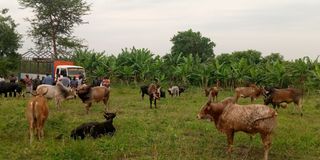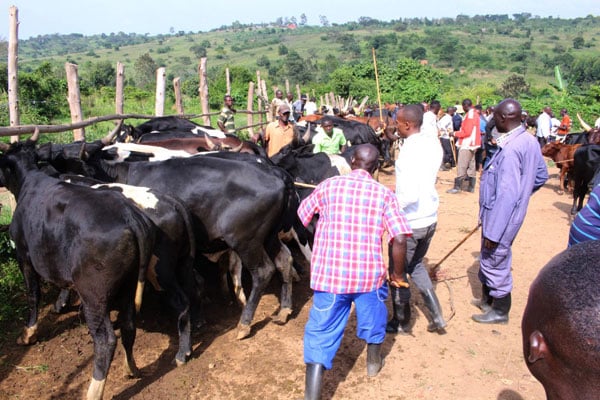Livestock traders stuck after ban on animal movement

Cattle graze in Arua City on February 5. Livestock traders in northern Uganda are crying foul after government restricted the movement of animals as part of the ongoing eviction of Balaalo (pastoralists). PHOTO | SANTO OJOK
What you need to know:
- According to the guidelines, for livestock to move for any purpose within Lango, Acholi and West Nile sub-regions, owners must obtain a letter of “no objection” from the district where the animals are being taken before a movement permit is issued by the veterinary officer of the district of origin.
Livestock traders in northern Uganda are crying foul after government restricted the movement of animals as part of the ongoing eviction of Balaalo (pastoralists).
Daily Monitor has established that many livestock traders are stuck with animals which they hoped to sell at the cattle markets.
Mr Milton Oculi, a cattle trader in Apac District, said he is stuck with 18 bulls which he bought recently with the intention of reselling them in Arua City.
“We are so disappointed in this business. There are soldiers who have been deployed on the roads to stop us from going to the market. We have bought cattle for sale but some of these animals are now injured,” he said on Monday.
Mr Denis Omala, another cattle trader in Oyam District, said he is worried that financial institutions may sell their homes over failure to pay back loans they obtained if the restrictions are not lifted soon.
“I am taking care of very many children but the government is blocking us from accessing the market to sell the livestock we have purchased. The bank is also demanding that we pay back the loans taken from them,” Mr Omala said.
Mr Boniface Oyuku, another cattle trader in Apac Municipality, appealed to the government to revise the restrictions.
“Our animals are now growing thin and their sell value is going down. We are appealing to the government to open for us the market because we got loans from banks and we are supposed to pay back the loans,” he said.
However, Mr Charles Opero, the Kwania District veterinary officer, urged cattle farmers to be patient.
“We received the guidelines on the restrictions on the movement of animals running from February 1 to March 31, 2022 and according to the government, the restriction is to prevent the spread of animal diseases and to help in monitoring the movement of Balaalo herdsmen,” he said via telephone yesterday.
The Maruzi North County Member of Parliament, Mr Nelson Lemba Okello, who had a meeting with the affected livestock traders on Monday, pledged to forward the matter to Parliament for intervention.
Livestock movement guidelines
The guidelines were issued by the Ministry of Agriculture, Animal Industry and Fisheries on January 28.
According to the guidelines, for livestock to move for any purpose within Lango, Acholi and West Nile sub-regions, owners must obtain a letter of “no objection” from the district where the animals are being taken before a movement permit is issued by the veterinary officer of the district of origin.
Under this arrangement, transporting livestock for slaughter must be conducted through designated routes.
The routes include Karuma-Pakwach-Nebbi-Arua, Karuma-Gulu-Kitgum, Gulu-Amuru-Lira, Apac-Lira-Kitgum, Apac-Kamdini, Lira-Kamdini.
The guidelines took effect on February 1 and are to last until March 13, 2022.




